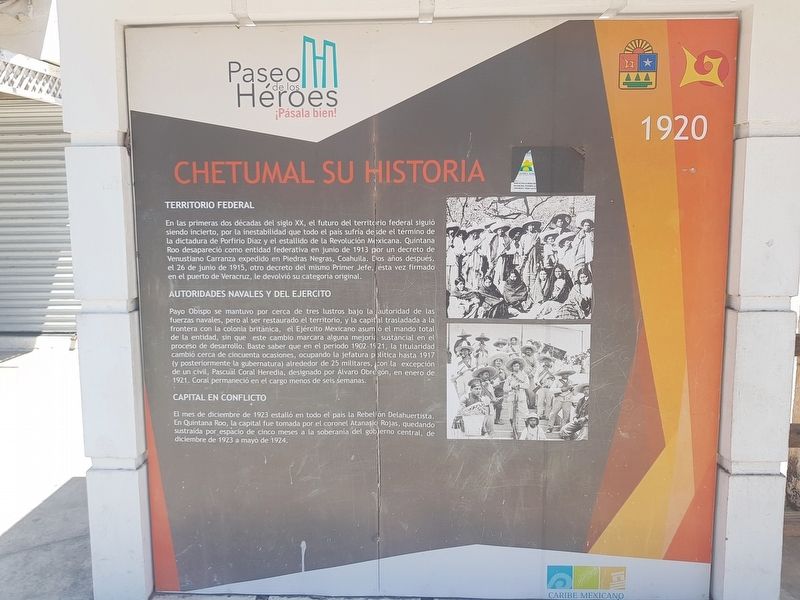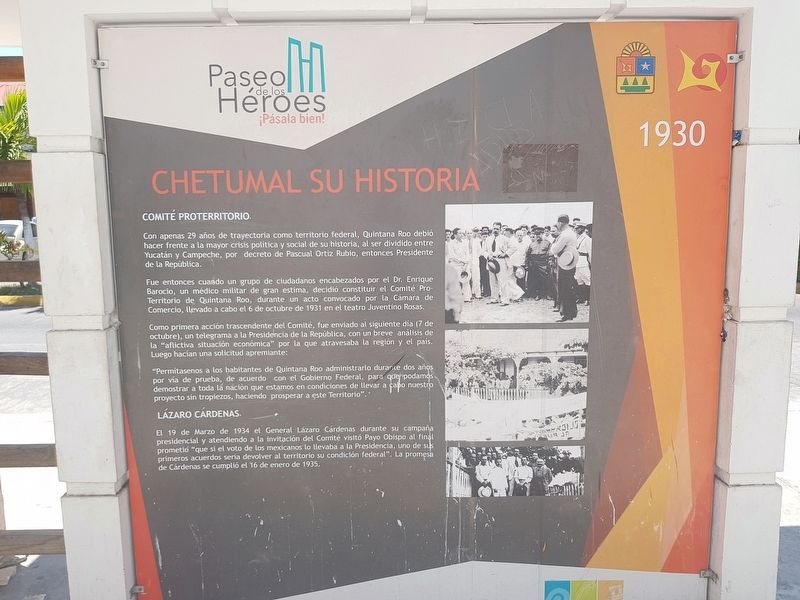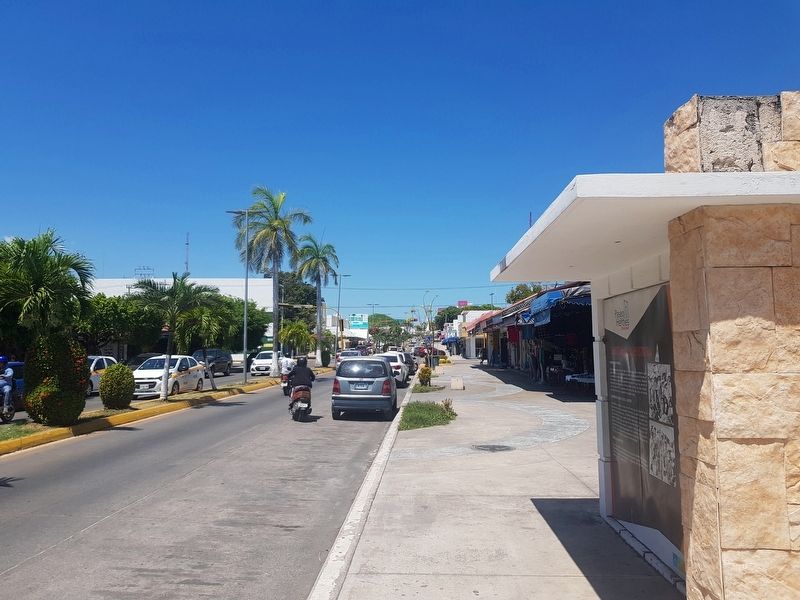Chetumal in Othón P. Blanco, Quintana Roo, Mexico — The Yucatan Peninsula (The Southeast)
The History of Chetumal 1920-1930
Paseo de los Héroes
Inscription.
Territorio Federal
En las primeras dos décadas del siglo XX, el futuro del territorio federal siguió siendo incierto, por la inestabilidad que todo el país sufría desde el término de la dictadura de Porfirio Díaz y el estallido de la Revolución Mexicana. Quintana Roo desapareció como entidad federativa en junio de 1913 por un decreto de Venustiano Carranza expedido en Piedras Negras, Coahuila. Dos años después, el 26 de junio de 1915, otro decreto del mismo Primer Jefe, ésta vez firmado en el puerto de Veracruz, le devolvió su categoría original.
Autoridades Navales y del Ejército
Payo Obispo se mantuvo por cerca de tres lustros bajo la autoridad de las fuerzas navales, pero al ser restaurado el territorio, y la capital trasladada a Ia frontera con la colonia británica, el Ejército Mexicano asumió el mando total de la entidad, sin que este cambio marcara alguna mejoría sustancial en el proceso de desarrollo. Baste saber que en el periodo 1902-1921, la titularidad cambió cerca de cincuenta ocasiones, ocupando la jefatura política hasta 1917 (y posteriormente la gubernatura) alrededor de 25 militares, con la excepción de un civil, Pascual Coral Heredia, designado por Álvaro Obregón, en enero de 1921. Coral permaneció en el cargo menos de seis semanas.
Capital en Conflicto
El mes de diciembre de 1923 estalló en todo el país la Rebelión Delahuertista. En Quintana Roo, la capital fue tomada por el coronel Atanasio Rojas, quedando sustraída por espacio de cinco meses a la soberanía del gobierno central, de diciembre de 1923 a mayo de 1924.
Chetumal Su Historia - 1930
Comité Proterritorio
Con apenas 29 años de trayectoria como territorio federal, Quintana Roo debió hacer frente a la mayor crisis política y social de su historia, al ser dividido entre Yucatán y Campeche, por decreto de Pascual Ortiz Rubio, entonces Presidente de la República.
Fue entonces cuando un grupo de ciudadanos encabezados por el Dr. Enrique Barocio, un médico militar de gran estima, decidió constituir el Comité Pro-Territorio de Quintana Roo, durante un acto convocado por la Cámara de Comercio, llevado a cabo el 6 de octubre de 1931 en el teatro Juventino Rosas.
Como primera acción trascendente del Comité, fue enviado al siguiente día (7 de octubre), un telegrama a la Presidencia de la República, con un breve análisis de la "aflictiva situación económica" por la que atravesaba la región y el país. Luego hacían una solicitud apremiante:
”Permitasenos a los habitantes de Quintana Roo administrarlo durarte dos años por vía de prueba, de acuerdo con el Gobierno Federal, para que podamos demostrar a toda la nación que estamos en condiciones de llevar a cabo nuestro proyecto sin tropiezos, haciendo prosperar a este Territorio”.
Lázaro Cárdenas
El 19 de Marzo de 1934 el General Lázaro Cárdenas durante su campaña presidencial y atendiendo a la invitación del Comité visitó Payo Obispo al final prometió “que si el voto de los mexicanos lo llevaba a la Presidencia, uno de sus primeros acuerdos sería devolver al territorio su condición federal”. La promesa de Cárdenas se cumplió el 16 de enero de 1935.
Chetumal and Its History - 1920
Federal Territory
In the first two decades of the 20th century, the future of the Federal Territory remained uncertain, due to the instability that the whole country suffered from the end of the dictatorship of Porfirio Díaz and the outbreak of the Mexican Revolution. Quintana Roo disappeared as a federal entity in June 1913 by a decree of Venustiano Carranza issued in Piedras Negras, Coahuila. Two years later, on June 26, 1915, another decree issued by the same president, this time signed in the port of Veracruz, restored its original status.
Naval and Army Authorities
Payo Obispo remained nearly 15 years under the authority of the Naval forces, but when the territory was restored, and the capital moved to the border with the British colony of Belize, the Mexican Army assumed total control of the entity, without this creating any substantial improvement in the development of the territory. As an example of this, in the period 1902-1921, the leadership changed about fifty times, occupying the political leadership until 1917 (and later the governorship) about 25 soldiers, with the exception of one civilian, Pascual Coral Heredia, appointed by Alvaro Obregón in January of 1921. Coral remained in office less than six weeks.
Capital in Conflict
In December 1923, the Delahuertista Rebellion exploded throughout the country. In Quintana Roo, the capital was taken over by Colonel Atanasio Rojas and removed for five months from the sovereignty of the central government, from December 1923 to May 1924.
Chetumal and Its History - 1930
The Pro-Territory Committee
With just 29 years of experience as a federal territory, Quintana Roo had to face the greatest political and social crisis in its history, being divided between Yucatán and Campeche, by decree of Pascual Ortiz Rubio, then President of the Republic.
It was then when a group of citizens led by Dr. Enrique Barocio, a military doctor of great esteem, decided to set up the Pro-Territory Committee of Quintana Roo, during an act convened by the Chamber of Commerce, performed on October 6, 1931 at the Teatro Juventino Rosas.
As the first transcendent action of the Committee, a telegram to the Presidency of the Republic was sent the following day (October 7), with a brief analysis of the "grave economic situation" that the region and nation was going facing. Then they made an impressive request:
"Let the inhabitants of Quintana Roo manage it for two years as a test, in agreement with the Federal Government, so that we can demonstrate to the whole nation that we are able to carry out our project smoothly, making this Territory thrive."
Lázaro Cárdena
On March 19, 1934 General Lázaro Cárdenas, during his presidential campaign and attending the invitation of the Committee, visited Payo Obispo and promised "that if the vote of the Mexicans took him to the Presidency, one of his first agreements would be to return to the territory its federal status." Cárdenas' promise was fulfilled on January 16, 1935.
Topics. This historical marker is listed in these topic lists: Government & Politics • Wars, Non-US. A significant historical month for this entry is January 1921.
Location. 18° 29.974′ N, 88° 17.77′ W. Marker is in Chetumal, Quintana Roo, in Othón P. Blanco. Marker is on Avenida de los Héroes just north of Avenida General Plutarco Elías Calles, on the right when traveling north. Touch for map. Marker is in this post office area: Chetumal QR 77000, Mexico. Touch for directions.
Other nearby markers. At least 8 other markers are within walking distance of this marker. Cuauhtémoc (within shouting distance of this marker); Quintana Roo State Seal (about 90 meters away, measured in a direct line); The History of Chetumal - 1937-1955 / 1960-2016 (about 120 meters away); Juventino Rosas Theater (about 120 meters away); Avenida 5 de Mayo No. 132 (about 150 meters away); Avenida 5 de Mayo No. 132-A (about 150 meters away); Hurricane Janet (about 180 meters away); Benito Juárez García (about 180 meters away). Touch for a list and map of all markers in Chetumal.
Credits. This page was last revised on May 18, 2019. It was originally submitted on May 18, 2019, by J. Makali Bruton of Accra, Ghana. This page has been viewed 175 times since then and 34 times this year. Photos: 1, 2, 3. submitted on May 18, 2019, by J. Makali Bruton of Accra, Ghana.


